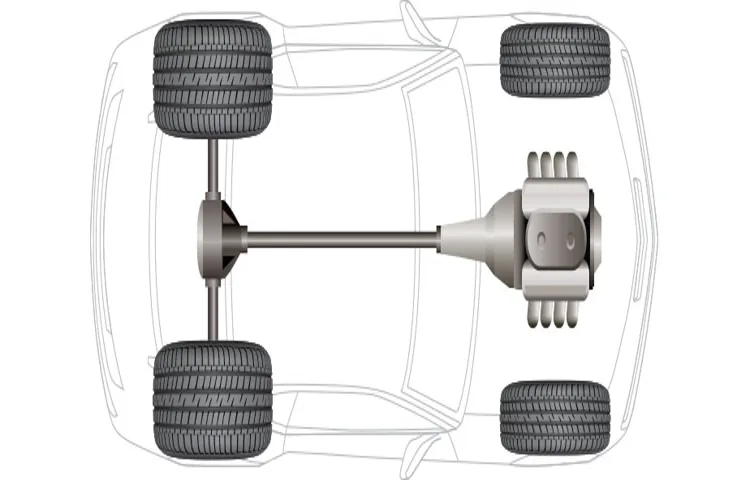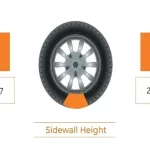If you’ve ever been to a race track, you might have noticed that the tires on race cars are not all the same size. This is because of tire stagger, a crucial aspect of racing that many people may not be familiar with. In simple terms, tire stagger refers to the difference in circumference between the rear and front tires on a car.
While it may seem like a small detail, tire stagger can have a significant impact on a race car’s performance. If you’re interested in racing or just want to learn more about tire stagger, keep reading to get a detailed explanation of everything you need to know.
Table of Contents
What is Tire Stagger?
Tire stagger is the difference between the circumference of the right and left tires on a car. It affects how the car handles and can be adjusted to improve performance. Essentially, one tire will have a larger circumference than the other, which can cause the car to pull in one direction or the other.
To address this, mechanics will adjust the size of the tires or change their position on the car to create a more even ride. Proper tire stagger is important for high-performance racing, as it can affect the car’s grip on the road and its ability to take turns smoothly. While it might seem like a small detail, getting the right tire stagger can make a huge difference in the overall performance of a car on the track.
Definition of Tire Stagger
Tire Stagger refers to the difference between the circumference of the two rear tires of a racing car. The term “stagger” comes from the fact that the tires have a staggered circumference. This difference affects how the car turns and handles on the track.
The larger tire has to travel farther than the smaller tire, which causes the car to turn more smoothly. The amount of stagger used is based on several factors, including track conditions, tire widths, and the driver’s preferences. Tire stagger is an essential factor in racing, and getting it right can make all the difference between winning and losing a race.

How is Tire Stagger Measured?
Tire Stagger is an important factor to consider in motorsports. It is the difference in circumference between the two rear tires of a car. The concept of Tire Stagger is used to help compensate for the difference in the speeds of the outside and inside wheels during a turn.
By measuring the difference in circumference, a team can adjust the size of the tires to decrease or increase the stagger. This can affect the handling of the car, allowing it to run smoothly and efficiently. Teams can measure Tire Stagger using a powerful device called a Stagger Gauge.
This tool measures the circumference of each tire and calculates the difference. By paying close attention to the Tire Stagger, drivers and teams can make precise adjustments to ensure the best possible performance on the track.
Why is Tire Stagger Important?
Tire stagger is a term used to describe the difference in circumference between the left and right side tires on a race car. It’s an essential component of a race car’s handling, and its importance cannot be overstated. When a car turns, the forces acting on the tires can cause the outside tire to spin faster than the inside tire.
This difference in speed can cause the car to lose traction and slide, affecting both speed and handling. By using staggered tires, with a slightly larger circumference on the outside tire, the car can maintain traction and stability, resulting in a faster lap time and a competitive edge on the track. Tire stagger is not a one-size-fits-all approach and requires fine-tuning for specific track conditions and driver preferences.
Taking the time to perfect the tire stagger can make all the difference in achieving success on the race track.
Improved Cornering Ability
Tire stagger is an important aspect to consider when it comes to improving cornering ability. Tire stagger refers to the difference in circumference between the left and right rear tires. This stagger can help to improve handling and cornering by compensating for the differences in track banking and weight distribution.
When the outside tire has a larger circumference, it covers more ground during a turn, which helps to reduce the effects of understeer. Similarly, when the inside tire has a smaller circumference, it helps to limit oversteer. By optimizing tire stagger, you can improve your vehicle’s performance, reduce tire wear, and ultimately achieve faster lap times.
So, the next time you’re on the track, make sure to pay attention to your tire stagger!
Better Tire Wear
Tire stagger plays a crucial role in ensuring better tire wear for your vehicle. In simple terms, tire stagger refers to the difference in height between the tires on the front and rear axles of your car. This is important because it determines how each tire interacts with the road surface, especially during cornering.
By having a slight difference in height between the front and rear tires, you can ensure that the tires on the outside of a turn have more contact with the ground, resulting in better traction and handling capabilities. This, in turn, reduces tire wear by distributing the load more evenly across all four tires. Having the right tire stagger can also help maintain tire alignment and balance, and even improve fuel efficiency by reducing rolling resistance.
So, if you want your tires to last longer and perform better, make sure to pay attention to your tire stagger measurements.
Maximization of Tire Grip
When it comes to maximizing tire grip, there are plenty of factors that come into play. One of the most important, often overlooked, is tire stagger. Tire stagger essentially refers to the difference in height between one tire and another.
This might seem like a small detail, but it can have a big impact on overall grip and handling. With staggered tires, the surface area of each tire that is in contact with the road varies, which means that your car can better distribute its weight and maintain better traction on the road. This allows for better grip in turns, better acceleration and braking, and overall better control of your vehicle.
When it comes to race cars and other high-performance vehicles, tire stagger is considered one of the most critical factors in achieving peak performance. So if you’re looking to maximize your tire grip and get the most out of your car, don’t overlook the importance of tire stagger!
Factors to Consider when Setting Tire Stagger
Tire stagger is the difference in circumference between the front and rear tires of a race car. This is an important factor to consider when setting up a car for racing, as it affects the handling and performance of the car. A larger stagger will provide more grip to the rear and can help with turning, but can also create more tire wear and make the car unstable.
A smaller stagger will provide less grip to the rear and may make the car more difficult to turn, but can provide increased stability and reduce tire wear. Other factors that can affect tire stagger include the track surface, tire compound, and suspension setup. It is important to find the right balance between tire stagger and these other factors to ensure the best possible performance on the track.
Track Configuration
Setting tire stagger is a critical factor to consider when configuring the track for a racing event. Tire stagger is the variance in the circumference of the tires on opposite sides of the vehicle. Typically, the right side tires tend to be larger than the left side tires due to the banking of the turns on most tracks.
Setting tire stagger is essential to ensure the vehicle remains stable on the track and does not pull to one side. Several factors go into determining the appropriate tire stagger for a specific track. These include the shape of the track, banking of the turns, length of the straightaways, and track surface conditions.
Straight tracks require minimal stagger, while highly banked tracks may require more substantial stagger. Additionally, softer track surfaces require less stagger than harder surfaces. Factors such as weather and temperature can also affect tire stagger.
Properly setting tire stagger involves a combination of trial and error, technical knowledge, and experience. Teams will often adjust stagger throughout the race weekend, based on feedback from the drivers, changing track conditions, or the team’s performance. To achieve optimal performance, the driver’s input is critical to understand how the vehicle feels on the track.
Factors such as tire pressure, camber, and toe adjustments can all affect the vehicle’s handling, and must be considered when setting tire stagger. In conclusion, setting tire stagger is an important element of track configuration and plays a vital role in a vehicle’s performance. Several factors must be considered when determining the appropriate stagger for a specific track.
Understanding how tire stagger works and knowing how to adjust it is a critical aspect of achieving optimal performance on the track.
Vehicle Setup
When it comes to setting tire stagger on your vehicle, there are several factors to consider. One of the most crucial factors is track conditions. If you’re driving on a high-grip surface, you may need less stagger than you would on a low-grip surface.
Another factor to consider is the size and weight distribution of your vehicle. Generally, larger and heavier vehicles require more stagger to help with cornering and stability. Additionally, your driving style and the type of racing you’re doing can impact your stagger needs.
For example, drag racing typically requires a high amount of stagger to help with traction off the starting line. On the other hand, oval racing may require less stagger to help with turning. Keep in mind that setting tire stagger isn’t an exact science and may require some adjustments as you test and refine your setup.
Conclusion
In the world of racing, tire stagger is the secret weapon that separates the champions from the rest. With its precise measurement and distribution, tire stagger is akin to the perfectly tailored suit – it enhances the driver’s performance and elevates their style. Just like a good haircut or a great pair of shoes, tire stagger is an element of racing that can make all the difference.
So, the next time you hit the track, remember the importance of tire stagger and the impact it can have on your success. It’s the little details that add up to big victories.”
FAQs
1. What does tire stagger mean in racing terms? A: Tire stagger refers to the difference in circumference between the left and right tires on a race car. It’s used to help balance handling and maximize speed. 2. How is tire stagger measured? A: Tire stagger is measured by comparing the circumference of the left and right tires. The difference between the two is typically expressed in inches or millimeters. 3. Why is tire stagger important in oval racing? A: Oval tracks have a constant turning radius, which means the car is always turning to the left. Tire stagger helps compensate for this by creating a natural turning force that helps the car handle better and maintain speed. 4. What are some common tire stagger setups used in racing? A: There are several different tire stagger setups, such as “crossweight” and “side-to-side.” Each setup is designed to optimize handling and speed based on the specific track and race conditions. 5. How do teams adjust tire stagger during a race? A: Depending on how the car is performing, teams may adjust the tire stagger by changing the size or pressure of the tires, or by relocating weights on the car. These adjustments can be made during pit stops or with the use of onboard tools. 6. What are some common tire stagger problems that drivers face? A: Some common tire stagger problems include understeering (the car doesn’t turn enough), oversteering (the car turns too much), and “tight” or “loose” handling. Drivers must communicate with their team to diagnose and fix these issues. 7. How do tire stagger requirements differ between different types of racing? A: Tire stagger requirements can vary depending on the racing series, the track, and the type of car being raced. For example, NASCAR has different tire stagger limits for its Cup, Xfinity, and Truck series races. Other series may have no restrictions on tire stagger.


